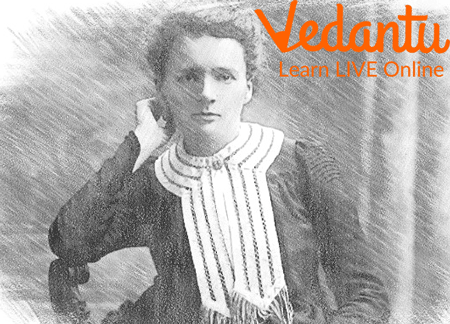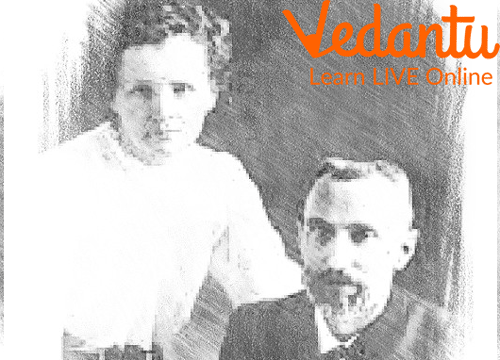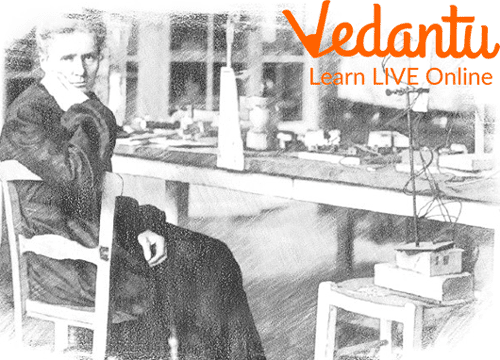




How Did Marie Curie Change Science Forever?
Marie Curie was a scientist in the field of radiation as well as a physicist and chemist. Together with her husband Pierre Curie, she discovered the elements Polonium and Radium. Together with Henri Becquerel, they were given the Nobel Prize in Physics in 1903, while Marie was given the Nobel Prize in Chemistry in 1911. Throughout her career, she spent a great time defining radium's many characteristics and exploring its medicinal possibilities. She passed away in 1934 from a blood condition, while she finally perished from her work with radioactive elements. Let us learn some facts about Marie Curie.

A Picture of Marie Curie
Early Life of Marie Curie
So, let us see who was Marie Curie. On November 7, 1867, in Warsaw, Poland, Marya (Manya) Salomee Sklodowska was born. She was the youngest of five kids and had three elder sisters as well as a brother. Her parents, Wladyslaw, her father, and Bronislava, her mother, were educators who made sure their daughters had the same education as their sons.
In 1878, Curie's mother passed away from illness. The author Barbara Goldsmith writes in her book "Obsessive Genius: The Inner World of Marie Curie" (W. W. Norton, 2005) that Curie's mother's passing had a very bad effect on her, feeding a lifetime of sadness and influencing her views on religion.
Curie finished secondary school in 1883 at the age of 15, taking first place in her class. The University of Warsaw would not accept women. Curie started working as a nanny at the age of 17 to help support her sister as she attended medical school in Paris. After finishing her studies on her own, Curie left for Paris in November 1891.
To appear more French, Curie signed her name as "Marie" when she registered at the Sorbonne in Paris. She received the Alexandrovitch Scholarship for Polish students studying abroad in appreciation of her abilities. She got her licenciateships in Physics and mathematical sciences in 1894.
Meeting Pierre Curie
Now let us see who was Pierre curie. Curie was given a research grant to investigate the chemical properties and magnetic characteristics of steel by one of her instructors. She met Pierre Curie, another outstanding researcher, during that study. In the summer of 1895, they got married.

An Image of Pierre Curie and Marie Curie
The piezoelectric effect, which occurs when electric charges are created by squeezing or applying mechanical stress to certain crystals, was discovered by Pierre when he was studying the science of crystallography. He also created many devices to measure electrical and magnetic fields. This helps us know a little bit about the biography of Pierre Curie and Marie Curie.
Discovery of X-Rays and Research
The discovery of X-rays by German scientist Wilhelm Röntgen and the discovery of analogous "Becquerel rays" by uranium salts by French physicist Henri Becquerel piqued Curie's interest. Goldsmith asserts that Curie applied a small coating of uranium salts on one of two metal plates. She then used devices her husband had created to gauge the intensity of the radiation the uranium was producing. The devices picked up the minute electrical currents produced when uranium rays were fired into the space between two metal plates. She discovered that uranium compounds also gave out comparable rays. Additionally, regardless of whether the compounds were in a solid or liquid condition, the rays' intensity remained constant.
More uranium compounds were tested by Curie. When she performed experiments with the uranium-rich ore known as pitchblende, she discovered that the mineral still released rays that were stronger than those produced by pure uranium even after the uranium had been extracted.
In a landmark report published in March 1898, Curie presented her research and introduced the term "radioactivity." According to Goldsmith, Curie made two groundbreaking observations in her work. According to Curie, monitoring radioactivity will facilitate the discovery of new elements. Additionally, the atom's radioactivity was a characteristic.

Marie Curie in her Lab
Frequently working into the night, Marie Curie stirred enormous cauldrons with an iron rod that was almost as tall as she was.
Two of the chemical components, one comparable to bismuth and the other to barium, were discovered by the Curies to be radioactive. The Curies' conclusion—which they published in July 1898—was that the combination resembling bismuth included a radioactive element that had not yet been identified. They gave it the name polonium in honour of Marie Curie's native Poland. By the year's end, they had discovered a second radioactive element, which they named radium after the Latin word for rays, "radius." The Curies revealed their achievement in 1902 in extracting purified radium.
When a horse-drawn wagon and Pierre Curie entered the street at the same moment in 1906, a sad event resulted in Curie's death. After that, Marie Curie became the first woman to hold the position of professor of general physics in the faculty of sciences at the Sorbonne.
Marie received a second Chemistry Nobel Prize in 1911 for discovering the elements polonium and radium. 2011 was dubbed the "International Year of Chemistry" in recognition of the 100th anniversary of her Nobel Prize. Apart from this she also has many Nobel prizes and accomplishments.
Summary
Here, we have learned how Polonium and radium were discovered by Marie Curie along with her husband Pierre. At the age of 66, Marie Curie passed away at the Sancellemoz Sanatorium in Passy, France, on July 4, 1934. Her aplastic pernicious anaemia, which she developed as a result of years of occupational radiation exposure, was identified as the cause of death. Eve (born 1898) and Irene (born 1898) were her two daughters (born 1904). So now we know, facts about Marie curie and the Nobel prize and accomplishments of Marie curie.
FAQs on Essential Facts About Marie Curie for Students
1. What are Marie Curie's most important scientific contributions?
Marie Curie is renowned for her pioneering research on radioactivity. Her most significant contributions include:
- The discovery of two new elements: Polonium (named after her native Poland) and Radium.
- Introducing the term 'radioactivity' to describe the phenomena of radiation emitted by certain elements.
- Being the first woman to win a Nobel Prize and the only person to win the Nobel Prize in two different scientific fields: Physics (1903) and Chemistry (1911).
2. How did Marie Curie discover the elements Polonium and Radium?
Marie Curie discovered Polonium and Radium through a meticulous process of chemical analysis. While studying a uranium-rich ore called pitchblende, she observed that it was significantly more radioactive than pure uranium. She hypothesised that other, undiscovered radioactive elements must be present. Through painstaking work, she and her husband, Pierre, chemically separated the components of tons of pitchblende, eventually isolating the two new, highly radioactive elements in 1898.
3. What is radioactivity, and why was Marie Curie's discovery about it so groundbreaking?
Radioactivity is the process by which an unstable atomic nucleus loses energy by emitting radiation. Marie Curie's research was groundbreaking because she correctly proposed that radioactivity was a fundamental property of the atom itself. This idea challenged the long-held scientific belief that atoms were indivisible and unchangeable. Her work laid the foundation for modern nuclear physics and our understanding of atomic structure.
4. In what ways did Marie Curie's research have a real-world impact, for example, in medicine?
Marie Curie's research had profound real-world applications, particularly in medicine. During World War I, she developed mobile X-ray units, nicknamed 'petites Curies' (little Curies), which were used on the battlefield to help surgeons locate bullets and shrapnel in wounded soldiers, saving countless lives. Furthermore, her discovery of radium became the basis for early cancer treatments, a field that evolved into modern radiation therapy.
5. Why was Marie Curie awarded two separate Nobel Prizes in different scientific fields?
Marie Curie's work spanned multiple scientific disciplines, earning her two distinct Nobel Prizes:
- Nobel Prize in Physics (1903): She shared this prize with her husband Pierre Curie and Henri Becquerel for their joint research on the radiation phenomena discovered by Becquerel.
- Nobel Prize in Chemistry (1911): She was awarded this prize alone for the discovery of the elements radium and polonium, for isolating radium, and for studying the nature and compounds of this remarkable element.
6. What were the dangers of Marie Curie's research, and how did it affect her health?
Marie Curie conducted her research without knowing the severe health risks associated with prolonged exposure to radioactive materials. She often carried test tubes of radium in her pocket and worked in a poorly ventilated shed. This constant exposure to high levels of radiation ultimately led to her death on July 4, 1934, from aplastic pernicious anaemia, a blood disease caused by damage to her bone marrow.
7. Who was Pierre Curie, and what was his contribution to the joint research?
Pierre Curie was a distinguished French physicist and Marie Curie's husband and research partner. His expertise was crucial to their success. He invented and perfected sensitive scientific instruments, most notably the electrometer, which could measure the faint electrical currents produced by uranium rays. This device was essential for quantifying radioactivity and enabled their groundbreaking discoveries of polonium and radium.









